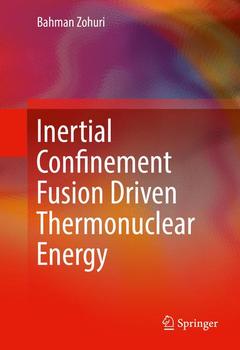About the Author
Preface
Acknowledgment
CHAPTER ONE: Short Course in Thermal Physics and Statistical Mechanics
1.1 Introduction
1.2 Ideal Gas
1.3 Bose-Einstein Distribution Function
1.4 Fermi-Dirac Distribution Function
1.4.1 The Grand Partition Function and Other Thermodynamic Functions
1.4.2 The Fermi -- Dirac Distribution Function
1.5 Ideal Fermi Gas
1.6 Ideal Dense Plasma
1.6.1 Thermodynamic Relations
1.6.2 Ideal Gas and Saha Ionization
1.7 Thomas--Fermi Theory
1.7.1 Basic Thomas--Fermi Equations
1.8 References
CHAPTER TWO: Essential Physics of Inertial Confinement Fusion (ICF)
2.1 Introduction
2.2 General Concept of Electromagnetisms and Electrostatics
2.2.1 The Coulomb's Law
2.2.2 The Electric Field
2.2.3 The Gauss's Law
2.3 Solution of Electrostatic Problems
2.3.1 Poisson's Equation
2.3.2 Laplace's Equation
2.4 Electrostatic Energy
2.4.1 Potential Energy of a Group of Point Charges
2.4.2 Electrostatic Energy of a Charge Distribution
2.4.3 Forces and Torques
2.5 Maxwell's Equations
2.6 Debye Length
2.7 Physics of Plasmas
2.8 Fluid Description of Plasma
2.9 Magneto-Hydro Dynamics (MHD)
2.10 Physics of Dimensional Analysis Application in Inertial Confinement Fusion ICF
2.10.1 Dimensional Analysis and Scaling Concept
2.10.2 Similarity and Estimating
2.10.3 Self-Similarity
2.10.4 General Results of Similarity
2.10.5 Principles of Similarity
2.11 Self-Similarity Solutions of the First and Second Kind
2.12 Physics of Implosion and Explosion in ICF--Self-Similarity Methods
2.13 Self-Similarity and Sedov - Taylor Problem
2.14 Self-Similarity and Guderley Problem
2.15 References<
CHAPTER THREE: Physics of Inertial Confinement Fusion (ICF)
3.1 Introduction
3.2 Rates of Thermonuclear Reactions
3.3 Critical Ignition Temperature for Fusion
3.4 Controlled Thermonuclear Ideal Ignition Temperature
3.5 Lawson Criterion
3.5.1 Inertial Confinement and Lawson Criterion
3.6 Bremsstrahlung Radiation
3.6.1 Bremsstrahlung Plasma Radiation Losses
3.6.2 Bremsstrahlung Emission Rate
3.6.3 Additional Radiation Losses
3.6.4 Inverse Bremsstrahlung Radiation in Inertial Confinement Fusion
3.7 Rayleigh-Taylor Instability in Inertial Confinement Fusion
3.8 Richtmyer-Meshkov Instability in Inertial Confinement Fusion
3.9 Filamentation Instability in Inertial Confinement Fusion
3.10 Kelvin-Helmholtz Instability
3.11 References
CHAPTER FOUR: Inertial Confinement Fusion (ICF)
4.1 Introduction
4.2 Overview of Inertial Confinement Fusion (ICF)
4.3 Inertial Confinement Fusion (ICF) Process Steps
4.4 A Path Towards Inertial Fusion Energy
4.4.1 Direct Drive Fusion
4.4.2 Indirect Drive Fusion (The Hohlraum)
4.4.3 Single Beam Driver as Ignitor Concept (Fast Ignition)
4.5 Inertial Fusion Confinement Implosion and Explosion Process
4.5.1 Linear Compression Concept
4.5.2 Cylindrical Compression Concept
4.5.3 Spherical Compression Concept
4.6 Basic Consideration for Fusion Target Design
4.7 Targets for Direct-Drive Laser Inertial Fusion Energy
4.8 Z-Pinch Target
4.9 Target Fabrication
4.10 Conclusion
4.11 References
Appendix A: Schrödinger Wave Equation
A.1 Introduction
A.2 The Time-Dependent Schrödinger Equation Concept
A.3 Time-Independent Schrödinger Equation Concept
A.4 A Free Particle inside a Box and Density of State
A.5 Heisenberg Uncertainty Principle
A.6 Pauli Exclusion Principle
Appendix B: The Stirling Formula
B.1 Proof of Stirling's Formula
Appendix C: Table of Fermi--Dirac Functions
C.1 Fermi-Dirac Functions
C.2 References
Appendix D: Tables of Thomas--Fermi Corrected Equation of State
Appendix E: Lagrangian and Eulerian Coordinate Systems
E.1 Introduction
E.2 Arbitrary Lagrangian Eulerian (ALE) Systems
E.3 References
Appendix F: Angular Plasma Frequency and High Power Laser
F.1 Plasma Frequency Introduction
F.2 High-Power Laser Fields Introduction
F.3 References
Appendix G: A Soliton Wave
G.1 Introduction
G.2 References
INDEX





